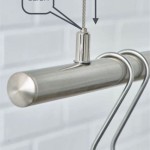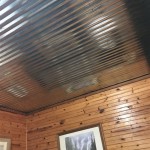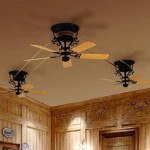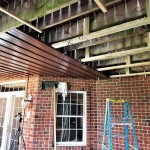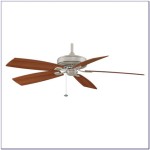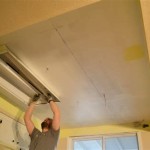Can You Put a Flush Mount Fan on Sloped Ceiling Joists?
Determining the feasibility of installing a flush mount ceiling fan on sloped ceiling joists requires careful consideration of several factors. While flush mount fans, also known as hugger fans, are designed for low ceilings, their application on sloped surfaces presents unique challenges. The compatibility depends primarily on the fan's design, the angle of the slope, and the structural integrity of the joists. This article explores the circumstances under which such an installation is possible, the necessary precautions, and alternative solutions for optimal functionality and safety.
Standard ceiling fans are typically designed to hang perpendicular to the floor. They incorporate a downrod that positions the fan blades at a certain distance from the ceiling. This design allows for adequate airflow and prevents the blades from hitting the ceiling, especially when the fan is operating at higher speeds. On a sloped ceiling, a standard fan with a typical downrod would hang at an angle, potentially compromising airflow and aesthetic appeal. Using angled downrods can mitigate this issue in many cases for standard fans. However, flush mount fans, lacking a downrod, present a different set of considerations.
The primary advantage of a flush mount fan is its minimal vertical clearance. This makes them suitable for rooms with low ceilings where a standard fan would hang too low, posing a safety hazard. However, this design also means that the fan housing is in close proximity to the ceiling. When mounted on a sloped surface, this close proximity may create installation and operational problems.
Understanding the Limitations of Flush Mount Fans on Sloped Ceilings
The first and foremost limitation stems from the design of the fan itself. Most flush mount fans are engineered with a flat mounting surface intended for horizontal ceilings. Attempting to directly attach such a fan to a sloped surface will result in an uneven installation, potentially straining the mounting bracket and the fan motor. This can lead to instability, excessive vibration, and premature failure of the fan. The degree of the slope is a crucial factor; a slight incline might be manageable with shims or minor modifications, but steeper slopes will generally necessitate a different approach.
Another challenge relates to airflow. A flush mount fan relies on the even distribution of air around the room. When installed on a slope, one side of the fan will be closer to the ceiling than the other, potentially obstructing airflow on the higher side and creating uneven air circulation throughout the room. This can diminish the fan's effectiveness in cooling or heating the space, negating the primary purpose of the installation.
Furthermore, the electrical box to which the fan is attached must be securely mounted to the ceiling joists. On a sloped ceiling, ensuring a robust and stable connection can be more complex. The weight of the fan, combined with the forces generated by its rotation, can put significant stress on the mounting system. If the electrical box is not properly secured, it could loosen over time, leading to a dangerous situation where the fan could detach from the ceiling. Therefore, a thorough assessment of the existing electrical box and its attachment to the joists is essential before attempting any installation.
Modifications and Considerations for Installation
While directly mounting a standard flush mount fan on a sloped ceiling is generally not recommended, there are some situations where modifications can make it feasible. However, these modifications should only be undertaken by individuals with experience in electrical and structural work, or preferably, by a qualified electrician and contractor.
One potential modification involves creating a level mounting surface. This can be achieved by building a small platform or frame that is attached to the sloped ceiling joists. The platform should be constructed of sturdy material, such as wood, and must be securely fastened to the joists. The electrical box can then be mounted to the platform, providing a level surface for the flush mount fan. This approach requires careful planning and precise execution to ensure that the platform is both structurally sound and aesthetically pleasing.
Another consideration is the use of shims. Shims are thin, tapered pieces of material that can be inserted between the fan mounting bracket and the ceiling to compensate for slight variations in the slope. While shims can be helpful in minor adjustments, they are not suitable for steeper slopes, as they can create instability and put undue stress on the mounting bracket. Furthermore, the use of excessive shims can be visually unappealing.
It is also crucial to inspect the fan's motor housing for any contact with the ceiling. Even with modifications, the close proximity of the fan to the sloped ceiling can lead to the motor housing rubbing against the surface. This can cause noise, vibration, and potential damage to both the fan and the ceiling. To prevent this, it may be necessary to further adjust the mounting system or choose a different fan model with a lower profile.
Prior to any installation, it is imperative to consult the manufacturer's instructions for the specific flush mount fan being used. The instructions will provide guidance on the permissible mounting angles, weight limits, and any specific requirements for sloped ceilings. Deviating from the manufacturer's instructions can void the warranty and create a safety hazard.
Alternative Solutions for Sloped Ceilings
Given the challenges associated with installing flush mount fans on sloped ceilings, exploring alternative solutions is often the most practical approach. Several types of ceiling fans are specifically designed for sloped ceilings, offering a more straightforward and reliable installation process.
Angled downrod fans are among the most common solutions. These fans utilize a downrod that is specifically angled to compensate for the slope of the ceiling. The angle of the downrod can be adjusted to ensure that the fan hangs level, providing optimal airflow and aesthetic appeal. Angled downrod fans are available in a wide range of styles and sizes, making it easy to find a model that complements the room's décor.
Another option is to use a universal ceiling fan adapter. These adapters are designed to be installed between the electrical box and the fan mounting bracket, providing a level surface for the fan. Universal adapters are compatible with most standard ceiling fans, including some flush mount models, and can be adjusted to accommodate various slope angles. However, it is important to verify that the adapter is rated to support the weight of the fan and that it is properly installed according to the manufacturer's instructions.
For rooms with very steep sloped ceilings, a pendant fan may be the most suitable option. Pendant fans are suspended from the ceiling by a long chain or rod, allowing them to hang freely and adjust to the angle of the slope. These fans are often used in rooms with vaulted ceilings or other architectural features that make standard ceiling fan installation difficult.
Furthermore, considering alternative cooling and heating solutions can be beneficial. In some cases, a wall-mounted fan, a portable air conditioner, or a space heater may be a more effective and efficient way to regulate the temperature in a room with sloped ceilings. These alternatives eliminate the challenges associated with ceiling fan installation and can provide targeted cooling or heating where it is needed most.
In conclusion, while it may be possible to install a flush mount fan on sloped ceiling joists with modifications, it is generally not the ideal approach. The design limitations of flush mount fans, combined with the challenges of creating a stable and level mounting surface, can make the installation complex and potentially unsafe. Exploring alternative solutions, such as angled downrod fans, universal adapters, or pendant fans, is often the more practical and reliable way to achieve optimal airflow and temperature control in rooms with sloped ceilings. A thorough assessment of the ceiling structure, the fan's specifications, and the applicable building codes is essential before undertaking any installation. Consulting with a qualified electrician and contractor is highly recommended to ensure that the installation is performed safely and correctly.

Electrical Mount Ceiling Fan At The Peak Of A Sloped Home Improvement Stack Exchange

Install Ceiling Fan On Sloped Simple Modern Handmade Home
How To Install A Ceiling Fan On Vaulted Quora

How To Install A Ceiling Fan On Sloped Lemon Thistle

Mounting Ceiling Fan On Sloped Home Improvement Stack Exchange

Electrical Mount Ceiling Fan At The Peak Of A Sloped Home Improvement Stack Exchange

Mounting Ceiling Fan On Sloped Home Improvement Stack Exchange

Fans On An Angle Installing Ceiling Angled Or Raked

How To Install A Ceiling Fan On Sloped Lemon Thistle

Mounting Ceiling Fan On Sloped Home Improvement Stack Exchange
Related Posts

